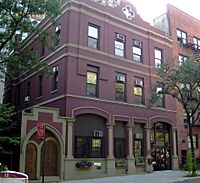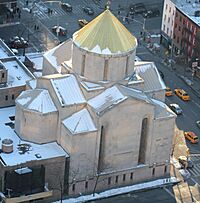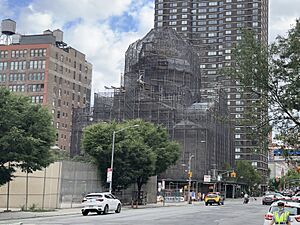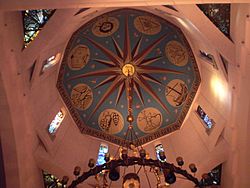St. Vartan Armenian Cathedral facts for kids
Quick facts for kids St. Vartan Armenian Cathedral |
|
|---|---|

The cathedral in 2010
|
|
| 40°44′42″N 73°58′31″W / 40.745131°N 73.975252°W | |
| Country | United States |
| Denomination | Armenian Apostolic Church (Mother See of Holy Etchmiadzin) |
| History | |
| Status | Cathedral |
| Dedication | St. Vartan |
| Consecrated | April 28, 1968 |
| Architecture | |
| Architect(s) | Walker O. Cain |
| Style | Armenian |
| Groundbreaking | May 2, 1965 |
| Construction cost | $3.5 million |
| Administration | |
| Diocese | Armenian Church of America (Eastern) |
St. Vartan Armenian Cathedral (which means "Saint Vartan Mother Church" in Armenian) is a special church in New York City. You can find it on Second Avenue in the Murray Hill area of Manhattan. This beautiful building looks like the Saint Hripsime Church in Armenia.
The cathedral was officially opened in 1968. It was the very first cathedral for the Armenian Apostolic Church built in North America. Next to the cathedral, there is an Armenian cultural center. There is also a diocesan house, which is like the main office for the church's Eastern Diocese in America.
Contents
History of St. Vartan Cathedral
Planning the Cathedral
People first started talking about building a cathedral in 1926. This idea came from the Armenian Church of America's Diocesan Assembly. But the plan had to stop because of the Great Depression. This was a time when many people lost their jobs and money.
In 1942, Archbishop Karekin Hovsepian suggested starting a fund. This fund would help pay for a new cathedral. It would also pay for offices and a cultural center. He wrote about how important this new church would be.
Choosing a Location
In 1945, the church decided to build the cathedral in New York City. Bishop Tiran Nersoyan was the new leader of the diocese. In 1947, he announced a plan to raise $1,000,000 for the project. At that time, the church leaders lived in a temporary house.
They chose a spot on the east side of Manhattan. It was near an area once called "Little Armenia." This location was good because the land was not too expensive. It was also easy to get to from the Queens–Midtown Tunnel.
The church bought the first piece of land in 1949. It was a large L-shaped area. Most of this land was bought from Columbia University. Some old buildings had been torn down there.
The church also bought a building at 630 Second Avenue. This building became the temporary home for the church leader. It also held the church offices. By 1952, the church owned even more land. This extra space allowed them to build the cathedral facing east. This is a special tradition in Armenian churches.
Building the Cathedral
Architects started making drawings for the cathedral. Demolition of the site began in April 1958. The church offices moved to St. Gregory the Illuminator Church nearby.
The first building they built was the diocesan house. This building would be the offices for the church. It would also be the home for the church leader. The first stone for this building was placed in January 1959. This brick and stone building cost $300,000. It was finished in November 1959.
In 1960, Vasken I, the head of all Armenian churches, visited. He held meetings in the new diocesan house. This was the first time such a high leader visited the diocese.
In May 1963, the architects for the cathedral were chosen. The groundbreaking ceremony for the cathedral happened on May 2, 1965. The first stone for the cathedral was blessed in October 1966. The Armenian cultural center opened in October 1967.
Finally, on April 28, 1968, the cathedral was officially opened. It cost $3.5 million to build. Vasken I named it after St. Vartan.
Life at the Cathedral
Starting in 1973, the cathedral held a "One World Festival" every year. This event showed off Armenian culture. It ran for 16 years. In 1976, six pear trees were planted. They were a memorial to areas lost during the Armenian genocide.
In 1978, a park nearby was renamed St. Vartan Park. It used to be called St. Gabriel's Park. The park was also used for the One World Festival.
The cathedral has been updated several times. In 1994, a $2.5 million renovation was finished. This included cleaning the outside walls. The dome was also re-covered with real gold. As of August 2025, the cathedral is undergoing another big renovation project.
Architecture of St. Vartan Cathedral
Walker O. Cain was the main architect for the cathedral. The Armenian Church also credits Rafayel Israyelian as an architect. His design was changed a little during construction. Édouard Utudjian from Paris helped as a consultant.
The building has two special features. These are common in Armenian architecture. One is the use of double-intersecting arches. The other is a pyramid-shaped dome. This dome rises 120 feet (about 36.5 meters) above the street.
Churches in Armenia used to be like forts. They had very thick stone walls. But St. Vartan Cathedral uses steel. This allowed the walls to be thinner. They are about 1 foot 1 inch (33 cm) thick.
Around the dome, you can see many symbols. There is a figure of Jesus Christ. A dove represents the Holy Spirit. You can also see the Greek letters Alpha and Omega. Wheat and grapes stand for the Eucharist. A Phoenix bird symbolizes new life.
The main walls of the cathedral have tall, narrow, stained-glass windows. These windows show scenes from the life of Christ. They also show early Christianity in Armenia. The church's patron saint, St. Vartan, is shown fighting. He fought to protect the Armenian Church long ago.
Plaza and Sculptures
On the south side of the cathedral is a large plaza. It is 72 feet (22 meters) wide and 100 feet (30.5 meters) long. This plaza is 5 feet (1.5 meters) higher than the sidewalk. The cultural center and diocesan house are next to it.
The plaza has a 10-foot (3-meter) tall bronze sculpture. It is called "Descent from the Cross." It was added in 1977. There is also a sculpture called "Migrations." It was added in 2015. This sculpture remembers the 100th anniversary of the Armenian genocide.
Below the plaza, there is an auditorium. It has a kitchen and serving area. This space is used for meetings and parties. You can get to it from a separate entrance on Second Avenue.





